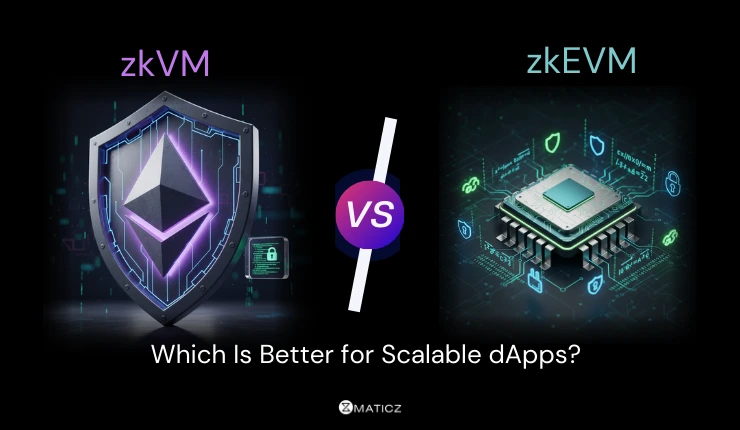Share Posts

How Will AI and Biometric Security Shape the Future of Crypto Wallets?
46
1149
103
The cryptocurrency landscape has undergone a significant transformation that has paved the way for the emergence of numerous cryptocurrencies. In digital finance, crypto wallet is not just a tool; they are the gateway to a decentralized ecosystem. Traditional wallet security methods such as two-factor authentication, seed phrases, and PINs are proving to be inadequate in the face of advanced cyber threats. Yet, as the value of digital assets grows, users expect more than just cold storage or mnemonic phrase protection.
These cyber threats raise a need to apply solid security for crypto wallets that hold these digital assets.
In this blog, let's take a look at how crypto wallets have evolved, uncover the current innovations in AI and biometrics, and imagine a future where these forces converge to redefine what it means to protect and interact with digital wealth.
The Evolution of Crypto Wallet
Crypto wallets have traveled a long journey and reflect the maturing needs of blockchain ecosystems since the inception of Bitcoin. As it was initially designed as basic tools to store private and public keys, early wallets lacked user-friendly interfaces and were accessible only to those with technical knowledge. As adoption grew, light wallets and mobile-based clients emerged, prioritizing performance, transaction speed, and user interface.
Today’s Crypto wallets support real-time dApp interactions, multi-chain operations, and integrations with layer-2 solutions, all while abstracting complexity for the end user. As we are moving to a future where AI and biometric integration are redefining the crypto wallet stack and set to power the next generation.
Both Artificial Intelligence (AI) and Biometric Authentication technologies are transforming from passive storage systems into intelligence and identity-based protection that empowers users with dynamic security, real-time threat detection, and effortless authentication.
AI: The Intelligent Guardian of Crypto Wallets
In today’s digital tech world, AI transforms your wallet into a predictive powerhouse. It plays a crucial role in modernizing wallet security and boosting the overall user experience. By continuous monetization, it deciphers usage patterns and preempting threats, and AI acts autonomously to safeguard your assets and minimize risk before issues arise. This dynamic approach offers real-time fraud detection and personalized transaction suggestions. AI redefines a simple digital wallet into a responsive, secure, and intelligent financial partner.
Role of Artificial Intelligence in Crypto Wallet Security
Real-Time Fraud Detection
AI scans every transaction and instantly spots suspicious things like high volume transfers, unauthorized or unusual behavior, and freezes the transaction as well as intercepts threats before execution.
Anomaly & Behavioral Pattern Analysis
AI continuously tracks the users' behaviours and helps businesses to gain insights into the login times, transaction history, and typical device usage. If any suspicious attempts are found, automatically AI indicates the act as unsafe and freezes the transaction.
Adaptive Risk Scoring
AI continuously evaluates each transaction by using real- time risk scoring algorithms. It allows low-risk transactions seamlessly, while high-risk actions may trigger additional security layers like biometric or multi-factor authentication.
Automated Threat Prediction
Instead of just reacting to threats, AI anticipates them. It constantly evaluates past cyber attacks to prevent future attacks. By analyzing global data and wallet activity trends, it proactively alerts users to scams or platform vulnerabilities.
Smart Transaction Verification
AI systems utilize behavioral profiling to assess transaction legitimacy. If something looks off, like transacting a large amount to a new user or unrecognized addresses, AI may prompt the user for confirmation or suggest double-checking the address.
Biometric Security: A New Identity Layer
In today's tech-savvy world, your body is the new key to ditching passwords. Biometrics turns on your unique biological traits, such as fingerprints, facial features, and voice recognition, to establish secure authentication protocols that are nearly impossible to replicate or steal. In the context of crypto wallets, it plays several critical roles to enhance both user experience and safety.
The Role of Biometric Authentication in Crypto Wallets
Secure Access Authentication
Biometrics eliminates the traditional password-based access by using facial recognition or fingerprint scanning to unlock wallets. This activity helps to reduce the risk of account compromise due to weak or stolen credentials.
Multi-Factor Authentication (MFA) Enhancer
As part of MFA, biometric scans provide a robust layer of security. Even if a malicious actor gains your private key or login credentials, they cannot proceed without your physical biometric verification.
Transaction Authorization
To mitigate risk, the system enforces biometric authentication for transactions deemed high-risk or unusual transactions. This ensures that sensitive actions are not just verified by the system but also physically approved by the rightful user.
Fraud Prevention
Biometric data plays a critical role in detecting fraud by validating user identity during anomalous login attempts, and provides verification to confirm the identity of the user and prevent unauthorized entry.
Seamless User Experience
Biometric systems enhance usability with real-time experience without compromising security. This reduces friction and maintains a high level of security without remembering long passwords or typing recovery phrases.
The Fusion: AI + Biometrics = Next-Gen Crypto Wallets
As the cryptocurrency ecosystem continues to evolve, users anticipate sophisticated functionality and robust security. As individuals, these two technologies already bring significant advancements in user experience and safety. Further combination of Artificial Intelligence (AI) and Biometric Security forms a multilayer security framework, and they’re redefining what the next generation of crypto wallets looks like.
Biometric authentication complements this by utilizing physiological identifiers such as fingerprint, facial geometry, and voice recognition, thereby mitigating risks associated with traditional authentication methods. This lowers the possibility of phishing scams, compromised credentials, and illegal access.
On the other hand, AI adds intelligence and adaptability. It continuously monitors fraudulent access attempts by leveraging machine learning and behavioural analytics. This allows crypto wallets to proactively identify suspicious activities, dynamically adjust security protocols, and deliver customized alerts before threats escalate.
The integration of Artificial Intelligence and biometrics forms a security layer. AI detects anomalies and forecasts risks, while Biometrics confirm that only you can authorize access or complete transactions. As it results in zero trust security frameworks where no access is granted without verification through multiple dynamic factors, and AI evaluates access requests instantly to approve, alert, or deny access, and it adapts security protocols based on individual user behavior, to avoid unnecessary alerts. Together, AI and biometrics offer a superior level of protection for cryptocurrency wallets that traditional passwords or even two-factor authentication can’t match.
How to Integrate AI & Biometrics Authentication in Crypto Wallet?
Integrating AI and biometric authentication has become a standard for modern crypto wallets as it significantly reduces the risk of unauthorized access. By using smart technology, this integration provides a powerful security upgrade as it spots threats and offers easy-to-use features like fingerprint or face recognition. Here’s a step-by-step guide to the integration process.
Define Security Objectives
From phishing attacks to suspicious logins, identifying the risks upfront helps you design the perfect mix of AI and biometric protection. This will guide your AI models and biometric use cases.
Choosing Biometric Modalities
Select suitable biometric methods based on your platform (mobile, desktop, hardware wallet). Common options include:
- Fingerprint recognition
- Facial recognition
- Voice authentication
- Multi-Modal Biometric
Deploy advanced authentication such as Face identification, fingerprint, and iris recognition to ensure secure on-device data storage using Secure Enclave, and enhance security layers in crypto wallet app development.
Implement AI-Based Behavior Analysis
Integrate AI models that track and analyze user behavior, such as typing, geolocation habits, and transaction patterns, to detect anomalies in real time. AI prevents fraudulent transactions in real time by analysing user habits.
Encrypt and Secure Data Storage
Make sure behavioral and biometric data is encrypted while it's in transit and at rest. Use a zero-knowledge architecture to avoid server-side vulnerabilities.
Overcoming Challenges in AI and Biometric Integration in Crypto Wallets
The fusion of Artificial Intelligence and biometrics promises a new era of secure and intelligent crypto wallets, as both technologies present a special set of ethical and technical difficulties. Addressing these issues is essential to ensure secure, reliable, and user-friendly systems.
Privacy Concerns
Biometric data is highly sensitive. Storing or processing this information, especially in a decentralized environment, will raise concerns about storage, access, and security.
False Positives and Negatives
AI systems and biometric recognition aren't perfect. If errors in AI or biometric recognition can either block valid users or allow unauthorized access. Ensuring high accuracy without compromising usability is a constant balancing act.
Data Security and Storage
Biometric data can’t be changed if compromised. That makes its protection critical. Developers must implement secure, encrypted storage solutions, ideally on-device, to prevent leaks or breaches.
Device and Hardware Compatibility
Biometric features vary across devices. Not all users have access to the latest technology, like face or fingerprint scanners, which can limit adoption or require alternative authentication pathways.
AI Bias and Fairness
AI algorithms can sometimes exhibit bias, especially in facial recognition systems, and ensuring the biometric systems are equally accurate across diverse populations is essential to prevent exclusion or unfair access restrictions.
Closing Thoughts
Both integration of AI and Biometrics play a major role that assisting businesses to enhance the security of crypto wallets. Unlike traditional methodologies, these AI provide real-time threat detection and behavioral analysis. And biometrics ensure identity via unique physical traits, users gain a powerful layer of protection, smartly and seamlessly. This combined fusion is addressing both threats and the usability challenges faced by traditional security models.
As the leading Crypto Wallet Development company, Maticz specializes in creating advanced, tamper-proof crypto wallet solutions that are AI-integrated, biometric-secure crypto wallets. With deeper expertise in AI implementation and biometric authentication, we empower startups and large-scale enterprises to launch next-gen crypto wallets that combine robust security with smoother user experiences.
Tap Into the Future
The latest insights, posts, and project updates - straight to your inbox.




